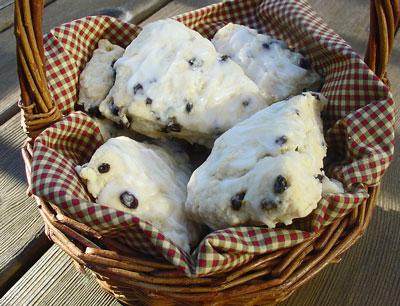Lemon Buttermilk Scones with Currants are a flaky and delicious scones with a burst of lemon flavor. They are fantastic served with coffee or tea, and especially wonderful to serve at afternoon tea with your friends. Lemon Buttermilk Scones with Currants are best served warm and fresh, split open, and topped with either lemon curd or thick homemade jam and clotted cream (Devonshire Cream or Creme fraiche).
I slightly adapted this wonderful Lemon Buttermilk Scone recipe. Recipe and photo were shared with me by my sister, Carol Arroyo, and her website called The Baking Pan.
Check out Linda’s History of English High Tea, English High Tea Menu, and Afternoon Tea Recipes.
More great Scone Recipes, Bread Recipes, Sourdough Bread Recipes, and Quick Bread Recipes for all your bread making.
- 1 cup whole wheat pastry flour
- 3/4 cup whole wheat flour
- 3/4 cup all-purpose flour
- 1/4 cup granulated sugar
- 2 teaspoons baking powder
- 3/4 teaspoon salt
- 6 tablespoons unsalted butter, cut into chunks and chilled*
- 1 large egg, cold*
- 3/4 cup buttermilk, low-fat, chilled*
- 1 tablespoon lemon zest (peel), grated
- 1/3 cup currants, dried
- 2/3 cup powdered sugar (confectioners' sugar)
- 2 tablespoons lemon juice, freshly squeezed
-
Preheat oven to 350 degrees F. Baking sheets may be ungreased, or lined with parchment paper.
-
Tip: Chill the bowl and any utensils you will be using in the refrigerator before making the scones.
-
In your food processor, add flours, sugar, baking powder, and salt; pulse several times to blend. Add the cold butter chunks and process until the mixture resembles coarse meal with a few larger chunks.
-
In a large bowl, whisk the egg, buttermilk, and lemon zest until blended. Add the flour mixture and the currants to the egg mixture and stir just until thoroughly moistened.
-
Turn the dough out onto a lightly floured surface and knead into a ball. Pat or roll the dough out into an 8-inch circle, approximately 1 to 1 1/4-inch thick. With a sharp, floured knife (flouring the knife before each cut prevents smashing the flaky layers when cutting), cut the dough into 8 wedges and place on prepared baking sheet, about 2 inches apart. Scones can be cut into any shape you desire. Use a drinking glass to make circles, or cut into squares or wedges with a knife. Dip the edges of the cutter in flour to prevent the dough from sticking. Do not pat the edges of the scone down; instead leave the cuts as sharp as possible to allow the scones to rise in layers.
-
Bake for 20 to 25 minutes, or until scones are lightly browned and a toothpick comes out clean. A good check is to use an instant digital thermometer to test your scones. The temperature of the scones should be at 200 degrees F. when done.
-
Remove from oven and let scones cool on the baking pan for approximately 5 minutes, then transfer to a cooling rack. Place parchment paper under cooling rack to catch icing drips.
-
In a small bowl, combine the powdered sugar and lemon juice to make a glaze. Drizzle over scones with a spoon while still warm. Allow icing to set and serve.
-
NOTE: These scones freeze very well; defrost, covered, at room temperature.
-
Makes 8 scones.
-
* Why do your ingredients need to be cold? It is important that your ingredients (both fats, liquids, and eggs) remain cold. The purpose is to keep the butter solid and not let it melt. If your dough is kept cold, it will have little bits of dispersed butter. In the heat of the oven, that butter melts into the dough but leaves pockets and layers in the scones. If it's hot in your kitchen, freeze your butter before making scones. Cold butter makes scones rise higher!
 I get many readers asking what cooking/meat thermometer that I prefer and use in my cooking and baking. I, personally, use the Thermapen Thermometer. Originally designed for professional use, the Super-Fast Thermapen Thermometer is used by chefs all over the world. I only endorse a few products, on my web site, that I like and use regularly.
I get many readers asking what cooking/meat thermometer that I prefer and use in my cooking and baking. I, personally, use the Thermapen Thermometer. Originally designed for professional use, the Super-Fast Thermapen Thermometer is used by chefs all over the world. I only endorse a few products, on my web site, that I like and use regularly.
You can learn more or buy yours at: Super-Fast Thermapen Thermometer.
Sponsored Content
Source: Recipe originally from Sunset Magazine, April 2006.

